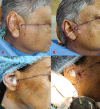Single-Puncture Versus Double-Puncture Technique Arthrocentesis in the Treatment of Internal Derangement of TM Joint-A Comparative Clinical Study
- PMID: 38105816
- PMCID: PMC10719202
- DOI: 10.1007/s12663-023-01986-5
Single-Puncture Versus Double-Puncture Technique Arthrocentesis in the Treatment of Internal Derangement of TM Joint-A Comparative Clinical Study
Abstract
Introduction: Tempormandibular Joint (TMJ) Disorders require early diagnosis with a prompt and effective treatment. Arthrocentesis has been found to be a valuable treatment aid for patients with early stage internal derangement of temporomandibular joints. The use of this procedure has been well documented in literature and had been performed for decades. Arthrocentesis under local anaesthesia can be performed in two different techniques i.e Single puncture and Double puncture techniques.
Aims and objectives: Our study was done to show the effectiveness of each of these techniques in aiding the patient as well as time taken to perform this procedure. Our study compares the two techniques to allow us to draw a proper conclusion on which can be put to use for better and less traumatic treatment of these patients.
Materials and method: For this study 50 patients with Internal Derangement, group A was 25 patients that were treated with Arthrocentesis of 200 ml RL using OnePrick TMJ Arthrocentesis System with Single Puncture technique and group B consisted of 25 patients who were treated with Arthrocentesis of 200 ml RL using Double Puncture technique.
Result: We found a significant increase in maximal mouth opening in patients undergoing arthrocentesis regardless of the technique. Comparison of mean duration of surgery performed among different groups were assessed using sample T test. Mean duration of technique A is around 17.18 minutes whereas for technique B is 20.90 minutes. The mean difference for two techniques performed is -3.722 with P value of 0.001. In technique A 24% of subjects needed additional lavage whereas in techniques B it is 20 %. On an average, total of 22 % of subjects needed additional lavage for better results. The resultant p value is around 0.733.
Discussion: The traditional double puncture technique involves the insertion of two needles into the upper joint space. Difficulties in accurate triangulation, positioning of the needle, and frequent intraoperative needle dislocations lead to longer operating times and are often encountered with the double puncture technique. On comparing the two arthrocentesis techniques in terms of easiness to operator a study done showed the group treated with single needle techniques found it easier than the double needle technique. The difference between groups was significant. The mean difference for two techniques performed was seen to be above three minutes in our study which was statistically significant.
Conclusion: Single needle technique is advantageous in the fact that it takes a shorter duration to perform, is less invasive and easier for the operator to complete successfully.
Keywords: Arthrocentesis; Internal Derangement; TMJ Disorders; Wilkies Classification.
© The Association of Oral and Maxillofacial Surgeons of India 2023. Springer Nature or its licensor (e.g. a society or other partner) holds exclusive rights to this article under a publishing agreement with the author(s) or other rightsholder(s); author self-archiving of the accepted manuscript version of this article is solely governed by the terms of such publishing agreement and applicable law.
Figures




Similar articles
-
Ultrasound-guided arthrocentesis using single-puncture, double-lumen, single-barrel needle for patients with temporomandibular joint acute closed lock internal derangement.Oral Maxillofac Surg. 2019 Jun;23(2):159-165. doi: 10.1007/s10006-019-00753-6. Epub 2019 Mar 28. Oral Maxillofac Surg. 2019. PMID: 30923970 Clinical Trial.
-
Comparison of intraoperative outcomes with single and double puncture techniques of arthrocentesis of the temporomandibular joint.Br J Oral Maxillofac Surg. 2020 Oct;58(8):928-932. doi: 10.1016/j.bjoms.2020.04.011. Epub 2020 Jul 16. Br J Oral Maxillofac Surg. 2020. PMID: 32684314
-
Single puncture arthrocentesis of temporomandibular joint; introducing a novel device: A pilot study.Natl J Maxillofac Surg. 2013 Jul;4(2):193-7. doi: 10.4103/0975-5950.127650. Natl J Maxillofac Surg. 2013. PMID: 24665175 Free PMC article.
-
Single puncture versus standard double needle arthrocentesis for the management of temporomandibular joint disorders: A systematic review.J Oral Rehabil. 2018 Oct;45(10):810-818. doi: 10.1111/joor.12665. Epub 2018 Jun 22. J Oral Rehabil. 2018. PMID: 29889989
-
Arthrocentesis techniques used in the treatment of temporomandibular disorders: Literature review.Stomatologija. 2021;23(4):95-100. Stomatologija. 2021. PMID: 35635520 Review.
Cited by
-
Update on Evidence and Directions in Temporomandibular Joint Injection Techniques: A Rapid Review of Primary Research.J Clin Med. 2024 Jul 10;13(14):4022. doi: 10.3390/jcm13144022. J Clin Med. 2024. PMID: 39064062 Free PMC article. Review.
-
Arthrocentesis of Temporomandibular Joints-A Clinical Comparative Study.Life (Basel). 2024 Dec 3;14(12):1594. doi: 10.3390/life14121594. Life (Basel). 2024. PMID: 39768302 Free PMC article.
References
LinkOut - more resources
Full Text Sources
